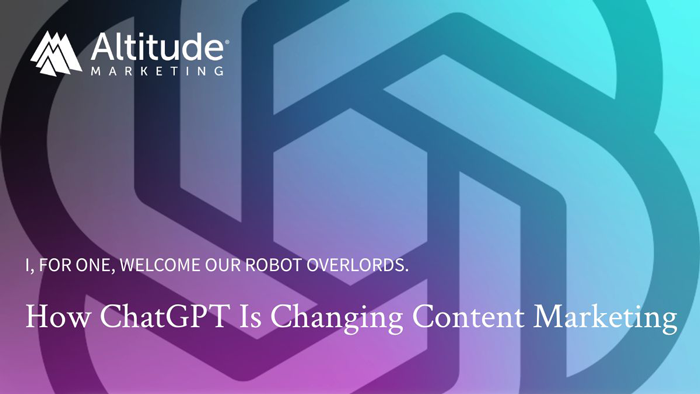Unless you’ve been living under a rock, you’ve heard of ChatGPT. OpenAI’s generative AI rockstar is making huge waves in the marketing world. Enterprise providers are using it at massive scale. Others are making sure they have similar capabilities. And everyone’s terrified the robots are coming to take our jobs.
Beyond the hype, though, is a day-to-day reality. ChatGPT is ultimately a content tool. It’s a robot writer. That means it has the potential to change content marketing in general, and B2B content marketing in particular.
The questions never stop. How do you use ChatGPT for content marketing? Is ChatGPT good for SEO? Will ChatGPT even affect SEO? Can you use ChatGPT for website content? What is ChatGPT best for? Let’s get to the bottom of it by exploring how ChatGPT works with B2B content marketing.
How Is ChatGPT Changing B2B Content Marketing?
- Improved workflow efficiency
- Better SEO
- Removing unnecessary human elements
- Breaking through the blank page
ChatGPT Basics
Before we dive into ChatGPT for B2B content marketing, we need to understand what ChatGPT is, and how it works.
What is ChatGPT?
ChatGPT is a “generative pre-trained transformer” based on OpenAI’s GPT-4 large language model, which became available broadly for ChatGPT Plus users on March 14. In English, and less technically, it’s a content generator that’s easy for users to access.
Basically, the GPT-4 model (a successor to GPT-3.5) was fed near-endless amounts of text from the internet and publications. In AI-speak, this is “training.” The data it was given was classified and indexed, allowing the model to learn, say, the rhyme structure of a limerick, or Taylor Swift’s lyrical style.

The upshot is that the model can consistently predict the most likely word or language element to use. A formal email, for instance, typically starts with “Dear”, followed by a name. If you ask the model to write you a formal email, it will follow that format.
ChatGPT itself is an interface that sits on top of the GPT-4 LLM. It’s the car interior and steering wheel; the stuff humans interact with. It’s made special by:
- Accessibility – Most users access ChatGPT through a standard browser, and don’t pay to use it
- “Chatbot” interface – ChatGPT is meant to seem conversational. You prompt it the same way you’d prompt a human writer.
- Simple API – Perhaps most important, OpenAI has made ChatGPT/GPT 4 easy to plug into other applications. Want to use it right in Slack, or automatically write emails to users who filled out a form? It takes about 5 minutes using Zapier.
Is ChatGPT New?
This flavor of generative AI is novel. ChatGPT is cheaper, easier and more functional than old tools built on GPT-2. Its ability to “understand” prompts and produce human-sounding responses is impressive compared to previous generations. That’s why it’s broken through into the mainstream in ways apps like Unbounce’s Smart Copy never could.
Altitude CSO Adam Smartschan talks ChatGPT on a SAMPS webinar
What Can ChatGPT Do?
If you can do it with language, ChatGPT can do it – or at least try to. For instance, you’ll get good responses if you ask it to:
- Write an email
- Write a story or blog post (not this one, BTW)
- Give you ideas
- Tell you about a topic
- Shorten or improve existing content
- Analyze or write computer code
- Convert text from one form to another
Of course, there are limits. In particular, ChatGPT is currently poor at:
- Factual accuracy; it can’t “check” answers in any real way
- Math, particularly word problems
- Current events (its training is 2021 and before, though GPT-4 purports to have more recent information)
- Giving unique ideas
- Offering advice or solving real-world problems
Remember, ChatGPT is a language tool. It is not an all-knowing AI overlord. Its particular magic is how easy it is to use, and how human-sounding its responses are. But it’s not actually understanding anything. It’s predicting the most common word to use next. That ends up seeming great at first glance, but never offering much depth.
With all that in mind, how can ChatGPT improve (or at least change) your B2B content marketing?
ChatGPT for B2B Content Marketing
ChatGPT Improves Content Workflows
First things first, we should talk about editing. Fact is, ChatGPT always needs a human editor. It’s often wrong, and it’s often wrong in fun and unpredictable ways. Taking raw ChatGPT content and putting it on your blog is a bad idea.
That said, ChatGPT can definitely improve content marketing workflows. Think of it as an intern-level advisor. You don’t want it making business-critical decisions, but it can certainly give you some basic answers.
For example, ChatGPT helps content marketing workflows by:
- Shortening or clarifying existing writing
- Giving you ideas for new topics
- Creating basic content outlines
- Offering synonyms or wording options
Those sound pretty basic. Truth be told, they are … for a human. With ChatGPT, they’re instant and on-demand, 24/7. As a sounding board or a small task manager, OpenAI’s tool is magic.
ChatGPT Helps with SEO
Most marketer’s first thought about ChatGPT and SEO was that it was going to do the writing for them. While this is technically possible, it’s a bad idea.
Why?
Google rewards the best content and the best intent fit with the best rankings. If ChatGPT is capable of providing the best possible answer to a question, then sure – it can get you to No. 1. More likely, though, ChatGPT’s answer is generic and accessible to anyone with a login. At that point, your site is just a repository for robot-written junk that can be found anywhere. If it isn’t helping, it isn’t ranking.
So, forget about ChatGPT being a tool to crank 25 blog posts a day and blow away your traffic goals.
Instead, think of ChatGPT like an SEO power drill. It helps humans accomplish their tasks fast. You can assemble your Ikea furniture with the provided Allen wrench. But you’ll get done in a fraction of the time with a power drill and hex driver. You wouldn’t ask the end table to build itself; the results would be poor, as it’s an end table. But you, the human, don’t need to do everything manually.
Search engines want a lot of good content that helps readers. If you can move faster – by, say, having a robot give you post ideas or cleaning up a tricky sentence – you can provide exactly that. As a rule of thumb, if it’s repetitive with a clear outcome (e.g., an outline), ChatGPT can probably do it for you.
ChatGPT Removes Unnecessary Human Elements
Yes, I realize that sounds like Skynet. And no, we’re not at Bender’s “kill all humans.”
(Yet.)

Instead, ChatGPT gives us, alive humans, a unique view into the robot world. Here’s what I mean.
We – again, human – see things with perspective and bias. We like what we like, and we don’t like what we don’t like. Our meat brains are subject to confirmation and relevance and any number of other foibles.
AI is free of all that. The answers it gives you aren’t always human-level accurate, but they are reflective of massive amounts of data. And that data is two things:
- It’s the same stuff Google uses to make its decisions
- It’s reflective of “average” human behavior
Google is nothing if not an aggregator of everything humans do. It doesn’t make ranking decisions based on what one person likes. Instead, it tries to find the “right” answer based on mass behavior. Similarly, our individual preferences can easily lead us away from what the crowd wants.
When you’re doing B2B content marketing, you’re not producing for yourself. Yet, it’s almost impossible to truly remove yourself from the end product. You might skip information you find trivial, or ignore a subject you find boring.
That’s you. ChatGPT offers a far broader view. It removes idiosyncrasy and whim and emotion, and replaces it with cold, hard vanilla. If you want to know what you think, you can ask yourself. If you want to know what “typical” is, ask a robot that’s ingested more words than you ever could.
That’s good for your work’s mass appeal, and it’s great for SEO. Again, you don’t want ChatGPT writing your finished product, but you sure want it to weigh in. SEO is effectively a robot’s evaluation of your work. Robots can help you win the game.
ChatGPT Breaks Through the Blank Page
Every content marketer knows the particular terror of the blank page. You know what you need to do, and you know your deadline. But that Google Doc is staring at you, stark and white. It’s empty. You’re empty.
(Too much?)
OK, maybe you’re not “empty.” But when it comes to content, getting started is often the hardest part.
Enter ChatGPT.
There’s no reason not to prompt the model to start your post or article for it. Again, ask it like you’d ask an assistant. What it spits out probably won’t be amazing, but it’s there. And that matters a lot. All of a sudden, you’ve got something to go off of. When the blank page is in your face, that’s a huge deal.
You might even see some ideas or tacks you didn’t think of yourself!
tl;dr: ChatGPT for B2B Content Marketing
ChatGPT is not going to replace content marketers anytime soon. It’s not yet capable of producing high-quality, original, thought-provoking content. But when it comes to B2B content marketing, it has a number of applications.
ChatGPT is an indispensable tool for streamlining workflows and small tasks, creating more SEO content, removing bias, and getting your work started.
That’s going to be disappointing to some B2B content marketers. Early adopters who saw ChatGPT as a magic bullet aren’t going to get what they expected. But as a way to get more efficient and explore some new angles, ChatGPT is really something special.



